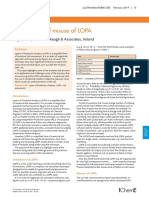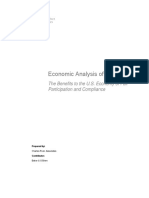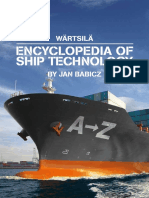IEA-GLE Workshop: LNG Safety Issues
IEA-GLE Workshop: LNG Safety Issues
Uploaded by
rarelimCopyright:
Available Formats
IEA-GLE Workshop: LNG Safety Issues
IEA-GLE Workshop: LNG Safety Issues
Uploaded by
rarelimOriginal Description:
Original Title
Copyright
Available Formats
Share this document
Did you find this document useful?
Is this content inappropriate?
Copyright:
Available Formats
IEA-GLE Workshop: LNG Safety Issues
IEA-GLE Workshop: LNG Safety Issues
Uploaded by
rarelimCopyright:
Available Formats
BG Group
IEA-GLE Workshop
May 19-20, 2005
Making Gas Markets Global
LNG Safety Issues
A. Acton LNG Development Manager BG Group
Safety of the LNG Industry
The LNG Industry has an excellent safety record
No LNG ship has ever had a major loss of LNG in ~40 000 loaded voyages No LNG tank built of suitable materials has ever failed catastrophically No member of the public has suffered a fatality due to a recorded incident at a LNG facility since 1944 A rolling study by the International LNG Importers Group currently shows less than 0.35 incidents of any concern (including near misses) per import terminal site-year since 1965
LNG facilities & ships are built & operated to strict standards
Location is based on study of incidents & hypothetical worst-case events Design is to international codes supported by Hazid, QRA, Hazop studies Operating licences require approved & regularly updated Safety Cases Key international organisations control & advise on LNG safety & security (GIIGNL, SIGTTO, IMO, OCIMF, Ship Class Societies, GLE, IGU) LNG Ports are subject to new security (ISPS) regulation from 2004 LNG safety and security are controlled by international systems and organisations
Safety of the LNG Industry
There is not and cannot be any room for complacency
A LNG tank made of non-cryogenic steel collapsed in 1944 A fire occurred during decommissioning of a LNG tank in 1973 A leaky LNG pump seal caused a switch room collapse in 1979 A liquefaction heat exchanger burst during maintenance in 1983 A LNG ship broke its moorings and LNG was spilt on the deck in 1989 A LNG road truck exploded after crashing on a mountain road in 2002 An explosion in a LNG liquefier caused extensive on-site damage in 2004
Members of the public now demand full information on potential hazards before construction is approved & LNG operations can start Heightened security based on advice from Government Security Services and Industry information sharing is required to protect people and fixed assets from potential risks due to increased terrorist activity in the world
The LNG Industry cannot afford to loose its excellent safety record
LNG Liquefier Explosion, January 2004
Train 40 Boiler
Center of Larger Explosion Approximate Location of Fence Damage
Incident analysis and photograph from US FERC-DOE Report, April 2004
Perceptions of LNG Safety & Security
The LNG Industrys safety record is exemplary, but this is not always understood by a public faced with proposed new LNG facilities Freedom-of-information legislation means that reporting has to be clear and understandable to the layman - hypothetical worst cases used in risk analysis must be understood as such The Internet has created an open platform for all views on LNG Incidents and near-misses are recorded by industry bodies and the results of analysis are reported within the industry and publicly Detailed independent reports are prepared for the few major incidents occurring There are many initiatives to improve procedures & educate new LNG operators and the public these need to be co-ordinated Recent work in the US and Europe has specifically covered security issues and appropriate actions have been taken Vigilance, openness, clear reporting and education can keep the LNG Industrys safety record & ensure its correct public perception
New LNG facilities to feed world energy demand need to be publicly accepted
You might also like
- Engine Timing Marks PDFDocument3 pagesEngine Timing Marks PDFFernando Moreira100% (2)
- The Heart of Worship - Bill WolaverDocument66 pagesThe Heart of Worship - Bill Wolaverrarelim98% (47)
- Styrene Monomer Safety Guide-1Document17 pagesStyrene Monomer Safety Guide-1rarelim100% (2)
- Scarborough FairDocument4 pagesScarborough FairSteven Sy LimNo ratings yet
- GAP XL Guidelines TOCDocument29 pagesGAP XL Guidelines TOCrarelim100% (1)
- Citation Study GuideDocument39 pagesCitation Study GuideJose Lara100% (5)
- SRK Report Central Kalimantan Coal ProjectsDocument70 pagesSRK Report Central Kalimantan Coal ProjectsREandoNo ratings yet
- ECAT Analysis GuideDocument12 pagesECAT Analysis GuideElder RuizNo ratings yet
- Diagrama Electrico 242BDocument4 pagesDiagrama Electrico 242Barmando_l_08100% (2)
- 134 Corby StarletDocument5 pages134 Corby StarletFrancisco SantosNo ratings yet
- Sea Change: Offshore Safety and The Legacy of Piper Alpha: AnalysisDocument3 pagesSea Change: Offshore Safety and The Legacy of Piper Alpha: Analysiscrackerz83No ratings yet
- The Buncefield Expolsion & Fire - Dr. David PainterDocument32 pagesThe Buncefield Expolsion & Fire - Dr. David PainterorlcostaNo ratings yet
- Shg-Sf-Ep-800-0006 - Rev0 - Afd - Passive Fire Protection Philosophy (Phase 3 Feed)Document27 pagesShg-Sf-Ep-800-0006 - Rev0 - Afd - Passive Fire Protection Philosophy (Phase 3 Feed)T-ru Loga RajanNo ratings yet
- Understanding Atmospheric Storage TanksDocument10 pagesUnderstanding Atmospheric Storage Tanksflashkickerazar100% (1)
- 5691 Gen Sa RPT 0016 0Document8 pages5691 Gen Sa RPT 0016 0ĐiệnBiênNhâmNo ratings yet
- FMDS0281 Act1119Document61 pagesFMDS0281 Act1119mkasNo ratings yet
- Feed-Back AMP2-AKOGEP PFP PhilosophyDocument6 pagesFeed-Back AMP2-AKOGEP PFP PhilosophyDubey DeepakNo ratings yet
- Foam System Hydraulic Calculation ReportDocument18 pagesFoam System Hydraulic Calculation ReportmoodydoodyNo ratings yet
- Comonomer PurificationDocument2 pagesComonomer PurificationJuvielyn Garcia100% (1)
- How To Perform QraDocument34 pagesHow To Perform QraKamal RajkumarNo ratings yet
- Assumption Sheet 01Document12 pagesAssumption Sheet 01Nambi PurushothNo ratings yet
- Alarm Management System With Sofrel S 510 Operation ManualDocument23 pagesAlarm Management System With Sofrel S 510 Operation ManualZewduErkyhunNo ratings yet
- Burnaby Fire Department - Evidentiary PaperDocument96 pagesBurnaby Fire Department - Evidentiary PaperNationalObserverNo ratings yet
- Ralf Bruyninckx Case 1 Fire Water NetworkDocument16 pagesRalf Bruyninckx Case 1 Fire Water NetworkBaba JohnehNo ratings yet
- P RefStd - 4043 - 004 - v091130 - EN - LOPADocument9 pagesP RefStd - 4043 - 004 - v091130 - EN - LOPAlucianduNo ratings yet
- GP 44-70Document54 pagesGP 44-70akohNo ratings yet
- Vess FireDocument21 pagesVess FirecsNo ratings yet
- How Do You Maintain Process Safety in Times of Change?Document4 pagesHow Do You Maintain Process Safety in Times of Change?Vikas NigamNo ratings yet
- BP Amoco Oil Hazard and Operability Studies (Hazop)Document37 pagesBP Amoco Oil Hazard and Operability Studies (Hazop)Pedro DiazNo ratings yet
- N05A 7 10 0 70030 01 05 Risk Assessment Dropped Object Analysis - SignedDocument45 pagesN05A 7 10 0 70030 01 05 Risk Assessment Dropped Object Analysis - SignedMustafa ShabanNo ratings yet
- 7 May 2015 EISC FLNG Safety ReportDocument331 pages7 May 2015 EISC FLNG Safety ReportSaraNo ratings yet
- Basic Phenomology of Deflagration, DDT and DetonationDocument16 pagesBasic Phenomology of Deflagration, DDT and DetonationHafez SoheimiNo ratings yet
- LNG UVCE MitigtionDocument47 pagesLNG UVCE MitigtionVăn HoàngNo ratings yet
- PhastDocument2 pagesPhastXiruo WangNo ratings yet
- Flares ImDocument270 pagesFlares ImnelsonsenaNo ratings yet
- Limitation and Misuse LOPADocument4 pagesLimitation and Misuse LOPARoslinormansyah RidwanNo ratings yet
- Accidents, Incidents, Mistakes, and The Lessons Learned From ThemDocument4 pagesAccidents, Incidents, Mistakes, and The Lessons Learned From ThemJesus ChristNo ratings yet
- Simplified Approaches To Fire and Explosion Engineering PDFDocument17 pagesSimplified Approaches To Fire and Explosion Engineering PDFfredo405No ratings yet
- SP 1126Document20 pagesSP 1126Venkat RanganNo ratings yet
- PrecautionsDocument15 pagesPrecautionsyajur_nagiNo ratings yet
- EPR ALARP AssessmentDocument5 pagesEPR ALARP AssessmentShaik MushtaqNo ratings yet
- General Standard: IPS-G-ME-100Document40 pagesGeneral Standard: IPS-G-ME-100Renalyn TorioNo ratings yet
- 11 - Overview of SOQRATESDocument25 pages11 - Overview of SOQRATESsNo ratings yet
- Safety Analysis Function Evaluation Chart: TBBM Tanjung Uban ProjectDocument3 pagesSafety Analysis Function Evaluation Chart: TBBM Tanjung Uban ProjectAriz Joelee ArthaNo ratings yet
- Aviation Transport Accident Statistics: Risk Assessment Data DirectoryDocument28 pagesAviation Transport Accident Statistics: Risk Assessment Data DirectoryLakshmi Binoy MenonNo ratings yet
- 07 Gexcon Francisco+HernandezDocument27 pages07 Gexcon Francisco+HernandezAndi SuntoroNo ratings yet
- Anhydrous Ammonia SafetyDocument33 pagesAnhydrous Ammonia SafetyYaltiNo ratings yet
- Karbala Refinary Project: Preparing Fatima Ali MahdiDocument28 pagesKarbala Refinary Project: Preparing Fatima Ali Mahdiضياء محمدNo ratings yet
- Hazardous AreasDocument118 pagesHazardous AreaskamalNo ratings yet
- Hazard IdentificationDocument2 pagesHazard IdentificationSultanNo ratings yet
- CH134R003 PDFDocument67 pagesCH134R003 PDFKids StrolaNo ratings yet
- Fire Water Pumps For CPI Facilities (CE)Document4 pagesFire Water Pumps For CPI Facilities (CE)jdgh1986No ratings yet
- 7.1.1 AAM HSE General Safety Standards - Design SpecificationsDocument41 pages7.1.1 AAM HSE General Safety Standards - Design SpecificationsIVAN ORTIZNo ratings yet
- #VIP 100220 Well EquipmentDocument43 pages#VIP 100220 Well EquipmentShady AhmedNo ratings yet
- C - Hazard ScenariosDocument16 pagesC - Hazard ScenariosNguyễnTrườngNo ratings yet
- MHDP-08-R-01 YDH BRA Full Report Issue 6.0 PDFDocument159 pagesMHDP-08-R-01 YDH BRA Full Report Issue 6.0 PDFbillNo ratings yet
- 5.7 Hazop V1.0Document14 pages5.7 Hazop V1.0abdulmarNo ratings yet
- ANP BRazil PresentationDocument17 pagesANP BRazil PresentationEDUARDO MADEIRA DE ALMEIDANo ratings yet
- 8 Vedlegg BDocument13 pages8 Vedlegg BGilang RomadhonNo ratings yet
- Hazard Analysis of Crude Oil Storage Tank Farm: International Journal of Chemtech Research November 2018Document10 pagesHazard Analysis of Crude Oil Storage Tank Farm: International Journal of Chemtech Research November 2018Redzwan KadirNo ratings yet
- OI - Briefing Note For Board Member Related To Safety DecisionsDocument54 pagesOI - Briefing Note For Board Member Related To Safety DecisionsPeddy NesaNo ratings yet
- MhdpIssue 6.1Document137 pagesMhdpIssue 6.1billNo ratings yet
- Fabrizio ViscoDocument35 pagesFabrizio ViscoKelvin XuNo ratings yet
- Ehs Weekly Data Report: Company: Pt. Viking - Day Shift Period 8-14NOV 2019Document1 pageEhs Weekly Data Report: Company: Pt. Viking - Day Shift Period 8-14NOV 2019Sanjay Kumar GhadaiNo ratings yet
- SCANDPOWER Human ResistanceDocument88 pagesSCANDPOWER Human ResistanceaNo ratings yet
- Buncefield Volume 2Document208 pagesBuncefield Volume 2Hammy223No ratings yet
- GAPS Guidelines: Special Extinguishing System ReviewDocument2 pagesGAPS Guidelines: Special Extinguishing System Reviewasad khanNo ratings yet
- Quantitative Risk Assessment A Complete Guide - 2020 EditionFrom EverandQuantitative Risk Assessment A Complete Guide - 2020 EditionNo ratings yet
- Anthony Veder FleetlistDocument1 pageAnthony Veder FleetlistrarelimNo ratings yet
- Oil Tanker Size Categories: AFRA Scale Flexible Market ScaleDocument1 pageOil Tanker Size Categories: AFRA Scale Flexible Market ScalerarelimNo ratings yet
- En 1473 - 07Document1 pageEn 1473 - 07NakkolopNo ratings yet
- Everlasting GodDocument1 pageEverlasting GodrarelimNo ratings yet
- Beautiful Saviour, God of Wonders, I Will Glory in My RedeemerDocument13 pagesBeautiful Saviour, God of Wonders, I Will Glory in My Redeemerrarelim100% (1)
- Port OperationsDocument41 pagesPort OperationsAllan Jason Burga67% (3)
- LNG Seis GuideDocument66 pagesLNG Seis GuideDeepak KukretyNo ratings yet
- Rupture of Crude Oil TankDocument12 pagesRupture of Crude Oil TankdndudcNo ratings yet
- Advantages of Globe ValvesDocument3 pagesAdvantages of Globe ValvesJohn Rey TumalaNo ratings yet
- Rps Motor Bensin (2) - 1Document15 pagesRps Motor Bensin (2) - 1fitria handayanitaNo ratings yet
- Micra Tech DataDocument8 pagesMicra Tech DataMshiboniumNo ratings yet
- Diesel Generator - : User ManualDocument32 pagesDiesel Generator - : User ManualRui FerreiraNo ratings yet
- 3dxl Wheeled Loaders PDFDocument8 pages3dxl Wheeled Loaders PDFShankar Lal JatNo ratings yet
- Manual and Remote Start Unit: Measurements DescriptionDocument2 pagesManual and Remote Start Unit: Measurements DescriptionmoaazabubakrNo ratings yet
- Andhra Pradesh Gas Power Corporation Ltd. (APGPCL) : Vijjeswaram-Stage-IiDocument2 pagesAndhra Pradesh Gas Power Corporation Ltd. (APGPCL) : Vijjeswaram-Stage-IiMohamed Sha NawazNo ratings yet
- Cummins - Kta19-G3a DatasheetDocument5 pagesCummins - Kta19-G3a DatasheetYU NICK100% (1)
- Sustainability in Energy and Buildings Results ofDocument320 pagesSustainability in Energy and Buildings Results ofchandasumaNo ratings yet
- CRA Report On IMO 2020 June 2019Document35 pagesCRA Report On IMO 2020 June 2019JCANo ratings yet
- 04 - LM2500 OverviewDocument27 pages04 - LM2500 OverviewLudovic Leroy100% (2)
- Igcse Chemistry Topic 14 Organic Chemistry AnsDocument57 pagesIgcse Chemistry Topic 14 Organic Chemistry AnsCClfourNo ratings yet
- Drilling Engineering - Dipl & PrasslDocument282 pagesDrilling Engineering - Dipl & Prassljultur4oNo ratings yet
- Engineering Standard: IPS-E-PR-340Document22 pagesEngineering Standard: IPS-E-PR-340Sadegh AhmadiNo ratings yet
- Trip Ticket Gasoline VoucherDocument1 pageTrip Ticket Gasoline Voucherrei_pimoNo ratings yet
- Final Practice-ProblemsDocument4 pagesFinal Practice-ProblemsMhd Donde Al HajNo ratings yet
- Encyclopedia of Ship TechnologyDocument663 pagesEncyclopedia of Ship TechnologyNAUTASNo ratings yet
- Sistemas de PotenciaDocument6 pagesSistemas de PotenciaEduardo VCNo ratings yet
- International Project References: Thyssenkrupp Industrial Solutions (India)Document8 pagesInternational Project References: Thyssenkrupp Industrial Solutions (India)Divyesh PatelNo ratings yet
- Stern-Drive: Operation ManualDocument60 pagesStern-Drive: Operation ManualJaime MksNo ratings yet
- Practical Training ReportDocument26 pagesPractical Training ReportNishant SharmaNo ratings yet
- Co-Heat Engine-Grade-9-FinalDocument8 pagesCo-Heat Engine-Grade-9-FinalApolonio Pamittan Jr.No ratings yet
- Operating Manual For Kipor Mobile Gic-Pg Kipor Quick Guide OmDocument8 pagesOperating Manual For Kipor Mobile Gic-Pg Kipor Quick Guide OmIan CutinNo ratings yet




































































































